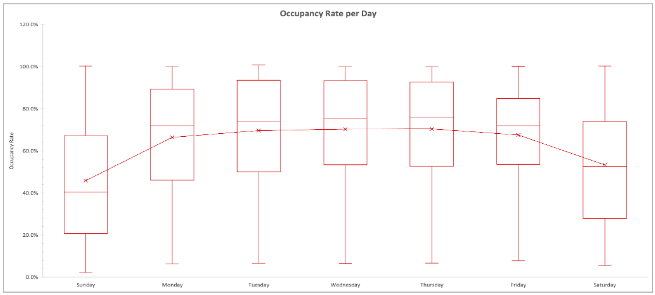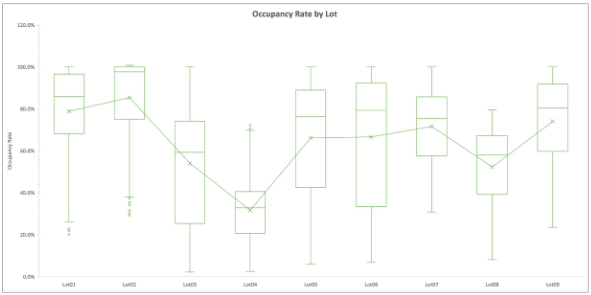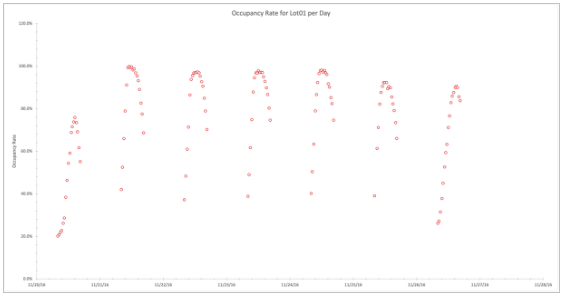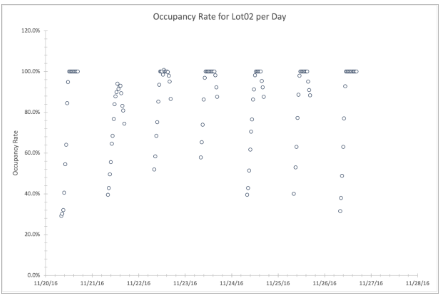Introduction
The primary purpose of this analysis is to investigate the need for the city budget to invest in the development of digital infrastructure to ease traffic in the city significantly. By now, we know that the main problem for city and non-city drivers is the choice of parking spaces. Parking lots are often unavailable, especially in the city center and near culturally significant areas, and those that are available are heavily overpriced for drivers. This situation is also known to be critical for the well-being of our population because it forces drivers to spend time searching for at least one free space near the place they are visiting. In turn, this aggravates traffic congestion, as dozens and hundreds of cars at a time are trying to find a free space, creating problems for free passage and including the movement of pedestrians. It is expected that this problem will only worsen when the city is expected to add new streams of residents.
Goal and Objectives
Thus, recognizing the current problem and the prediction of its aggravation, the purpose of this analysis is to draw a data-driven, informed conclusion about whether the city government should invest in the development of an intelligent parking system. In brief, this system, implemented through a mobile app, would allow drivers to determine the number of available spaces in city parking lots in advance and to structure their route more optimally. That is, the benefit of such an investment is to alleviate traffic and create a more favorable urban environment. To answer this question, we used data on the congestion of city parking lots, depending on the day of the week.
Boxplots for Days of the Week
To begin with, Occupancy Rates determine the occupancy of a particular parking lot and are calculated as the current occupancy divided by the total capacity of each parking lot. There are a total of nine parking lots in the city, and Occupancy Rates have been calculated cumulatively, that is, without specification at each specific parking lot. The boxplots shown on the slide show the dynamics of this rate during the week. One of the first conclusions that can be drawn from this data is that occupancy rates in city parking lots are always lower on weekends than on weekdays. This does not seem surprising since the population tends to vacation at home or out of the city on weekends commute to work, and need parking on weekdays (FHWA, 2020). That said, the average and median occupancy rates are the most telling.

As the graph shows, the average occupancy rate is lowest on Sunday and Saturday and then increases on Monday and Friday in ascending order, reaching an almost constant maximum on Tuesday, Wednesday, and Thursday. That is, it is in the middle of the work week that parking lots experience the greatest congestion. We should also pay attention to the median value, which determines the numerical threshold that cuts the distribution exactly in half (Ganti, 2022). The median value for Sunday is about 40%, which implies that exactly half of all parking spaces are less than 40% full on that day. For Saturday, this value is about 50%, for Monday and Friday, it is about 70%, and on the other days, it is higher than this value. The median is highest on Thursday, at around 76%. This implies that Thursday can be considered the busiest day, as more than half of the parking spaces are occupied by more than 76% on Thursday. The resulting values are generally in line with expectations, as they show that weekdays prove to be the most popular days for drivers looking for parking. The seeming discrepancy with Friday weekdays, traditionally the end of the working week, when the population visits bars and nightclubs en masse, can also be justified by the fact that on such days people may prefer to use cabs rather than private transport. It is worth clarifying that the conclusions drawn should be read with caution, as they do not mean that parking congestion cannot reach one hundred percent on other days; rather, they indicate only central trends for daytime distributions.
Boxplots for Parking Lots
As part of the analysis, it is also interesting to examine trends, not a temporal activity, but geographic, that is, for each of the nine parking lots. This will help determine whether some parking lots are more popular than others. As you can see from the figure on the slide, the average occupancy of each of the nine parking lots varies significantly. The lowest average occupancy is for Lot 4, while the maximum is for Lot 2. If we line up the parking lots in order of increasing their median value, we get the following ranking: #4 < #8 < #3 < #7 < #5 < #6 < #9 < #1 < #2. This means that parking lots No.1 and No.2 are the most congested parking lots in total compared to the others: their median is above 80%. Consequently, it is these parking lots that are the most popular with the public and can potentially create problems for traffic in the city. Clarifying the geographic location of these parking lots would help determine the reasons for their popularity. It is very likely that if they are located in crowded areas, then geographic convenience is the reason they are so highly congested.

Notably, Lot 01 and Lot 02 are not the largest parking lots. Lot 01 has 863 parking spaces, and Lot 02 has an even smaller capacity of 387. That said, the average parking capacity for all nine lots is 732, which makes one think of Lot02 as an extremely low-capacity lot. In this sense, the highest occupancy value for this lot may be due not so much to the attractive location but also the low capacity, resulting in almost 100 percent occupancy of the small parking lot.
Lot01 and Lot02: Focus
Now that it has become clear that it is the first and second parking lots that create the most problems for the city’s infrastructure due to their maximum congestion, as well as having completely different capacities, it is of great interest to examine these two locations more closely. To this end, two scatter plots will be constructed, showing the dependence of each parking lot’s congestion during the week of November 20, 2016, through November 26, 2016, that is Sunday through Saturday.
Lot01: Scatter Diagram

Fig. 3 shows a scatter plot for the first parking lot, with Occupancy Rate as the dependent variable. One interesting pattern is that lot occupancy is a cyclical function; that is, it increases at the beginning of the day and decreases over time because workers need parking in the first half of the day, and the need for it decreases at the end of the day. For this lot, the highest occupancy is true for Monday and then is virtually unchanged until Thursday. The lowest value is true for Sunday, during which the highest occupancy does not exceed 76%.
Lot02: Scatter Diagram

Fig. 4 shows a diagram for the second parking lot. Recall that its capacity is about three times lower than for the first parking lot. Nevertheless, the cyclicality of the function persists: this means that by the end of the day, the parking lot load usually drops. However, this is unfair for Sunday, November 20, when occupancy reaches the 100% mark by noon and does not fall after that. The same pattern is true on Saturday: by 11 a.m., all parking spaces are occupied and not vacated until the weekend. By contrast, the lowest occupancy pattern is true for Monday: it is the only day when lot occupancy does not reach 100%, stopping below the 90% mark. Accordingly, parking lot #2 can only be used for additional cars on Mondays
Lot01 vs. Lot 02
As follows from the two parking lots, the dynamics of their occupancy have similarities and differences. In both cases, as expected for all other lots, the occupancy has periodic dynamics and generally decreases by the end of the day. However, the maximum occupancy of lot #1 is observed at the beginning of the working week, whereas lot #2 was filled completely during five out of seven days. From this, we can conclude that the first lot has a few more available seats, at least on Saturday and definitely on Sunday, while for the second lot, the only day with available seats was Monday. At the same time, both lots show that they have seats available before 11 a.m., and they also often have seats available in the evening. This suggests that parking lot #2 might be a weekend parking lot, such as at culturally significant city facilities, while parking lot #1 might be considered an ordinary city lot
Conclusions of the Analysis
Based on the data obtained, we can conclude that the city does have a problem with the occupancy of parking lots. On average, weekdays are the busiest for the whole city, but this pattern is different, for example, for parking lot #2, which is Monday, which is the freest day. In addition, parking occupancy was cyclical; that is, the morning and evening hours were free: this is assumed to be true for all parking lots in the city. Accordingly, it is during these periods that there is the greatest number of free spaces.
As a complete conclusion, the evidence points to a positive need to invest in an intelligent parking management project. This will create opportunities to find free spaces for drivers and is expected to significantly reduce congestion. This project is especially expected to be attractive in terms of the increasing population that is projected in the future.
References
FHWA. (2020). Contemporary approaches to parking pricing: A primer. United States Department of Transportation — Federal Highway Administration. Web.
Ganti, A. (2022). Median: What it is and how to calculate it, with examples. Investopedia. Web.